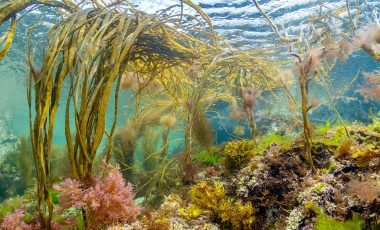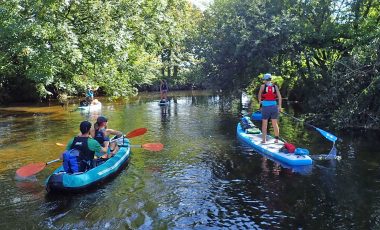Header image: Martin Stevens
The benefits of seaweed extend beyond that of a superfood, and it is also one of the most climate-friendly foods we can grow. Seaweed, or sea vegetables, are a form of algae that grows in the ocean or sea. It has a classic salty yet fishy taste and is commonly used in seaweed salad, soups, or sushi rolls.
Seaweed is also a vital food source for ocean life and can be found in shades of greens, reds, and browns. While there are thought to be over 10,0000 species of seaweed, the most popular food is Nori. This is likely what you buy if you like seaweed snacks or the dried sheets used for sushi. Other common varieties of seaweed used for food can include spirulina, wakame, dulse, kelp, and arame.
It is thought that seaweed truly is a superfood because of its health benefits, but it may also be a superfood for the environment. For a glimpse into all of the potential benefits of seaweed, we will explore the health benefits of seaweed and the environmental benefits.
- Health benefits of seaweed
- Environmental benefits of seaweed
- Foraging for seaweed
- Final thoughts on the benefits of seaweed

Health benefits of seaweed
Seaweed has impressive health benefits and is loaded with healthy vitamins and minerals. Like any food, it tends to be best when we eat it in whole food form, but the benefits of seaweed can also be obtained through superfood powders or in pill form. Most of the same benefits apply regardless of how you consume the seaweed, but eating it fresh or dried is a delicious and available way to get the same benefits.
Since we see it as a superfood of sorts, we can expect it to be a good source of vitamins, minerals, and other nutrients that may not always be a part of our daily diet.

Image by Cornish Seaweed
A few of the nutritional benefits of seaweed
- It contains a concentrated source of iodine
- High in amino acids like tyrosine
- Good source of omega-3 fats
- Some types can contain vitamin B12
- Source of other nutrients like iron and calcium
- It has antioxidant vitamins A, C, and E
- High in fibre
Certain things like iodine, B12, and omega fatty acids can be difficult to find in other areas of our diet without using supplements. Having a whole food source of these nutrients is an easy way to work them into a few meals or in a superfood smoothie.
Cautious consumption of seaweed
Some potential dangers of consuming too much seaweed, especially when supplementing with it, could be an excess of iodine or a heavy metal load. How you cook the seaweed and the foods you pair it with can change the iodine levels or even prevent some of your body’s iodine intake through your thyroid. While iodine is known to help with thyroid function, too much of it can also cause thyroid problems.
Since seaweed can store minerals in concentrated amounts, it can be the perfect vessel for consuming heavy metals like mercury, lead, and cadmium. Seaweed is often tested for heavy metal levels, and most of the seaweed you consume likely has some concentration of heavy metals. Unless you eat it daily or in excessive amounts, it should be a small enough amount to be harmless to your body, but these metals can be stored over time. Opting to buy organic seaweed is a way to potentially lessen the concentration of metals, but it doesn’t eliminate the risk.

Image by Martin Stevens
Environmental benefits of seaweed
It is no secret that agriculture has a significant impact on the environment, but seaweed is one of the few foods that may have a positive environmental effect. Oceans cover around 71% of the world’s surface, and with 38% of the world’s land already being used for agriculture, we need new food solutions. Not all plants have the same positive effect, but the ocean sequesters around 40% of carbon emissions.
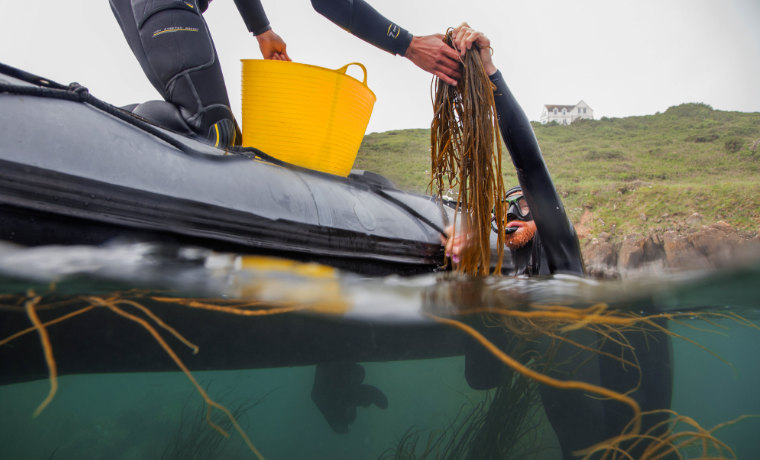
Image by Emli Bendixen
Some incredible and groundbreaking environmental benefits of seaweed
Part of the reason the ocean is an effective carbon sink is because of plants like seaweed. These coastal ecosystems containing seagrasses and seaweed have the potential to absorb more than 20 times the Co2 per acre than forests on land.
- Seaweed grows at a very fast rate, and beyond the seeding or planting of the seaweed, it does not require any fertilisers or freshwater, plus it does not contribute to land erosion. It doesn’t take up much space andprovides critical biodiversity hotspots in a dying ocean.
- Ocean acidification has begun to threaten many areas of the ocean, like coral reefs, and things like fish farming only contribute to the stress on these natural areas. By shifting the focus to regenerative farming practices that use no fertilisers or feed and do not threaten natural areas, we not only produce a sustainable food source, but it may help reduce ocean acidification along the way.
- With seaweed’s ability to grow so quickly and efficiently, regenerative seaweed farms are being studied and are showing promising signs of being easy to scale. This is good news because seaweed isn’t only a good source of food but also an option for biofuel.
- One criticism of biofuels like corn is the land and resources it takes to grow and produce. Seaweed can also be used as a biofuel by harvesting it to generate methane for electricity or a natural gas replacement. A 2012 study published by the University of the South Pacific showed that even if seaweed farms only covered about 9% of the ocean, they would produce enough biomethane to replace all of our current needs for fossil fuel energy. Plus, that amount of seaweed can do that, all while removing around 53 gigatonnes of Co2 per year.
- If all of that wasn’t enough, another widely utilised benefit of seaweed is its ability to clean waterways. This is especially helpful in areas with an oversaturation of nutrients like nitrogen or phosphorus in the water. Seaweed can often be brought alongside other natural cleansers like mussels and used together as a bioremediation tool.
The ocean, along with the rest of the planet, is in dire need of help, and while regenerative seaweed farming could be an effective way to sequester more carbon, the way we farm the ocean also needs improvement.
With the rise in interest in seaweed farming, it is essential to note that native seaweed species should be the only ones planted. While other varieties may be able to grow, preventing the spread of non-native species is important to preserving natural ecosystems.
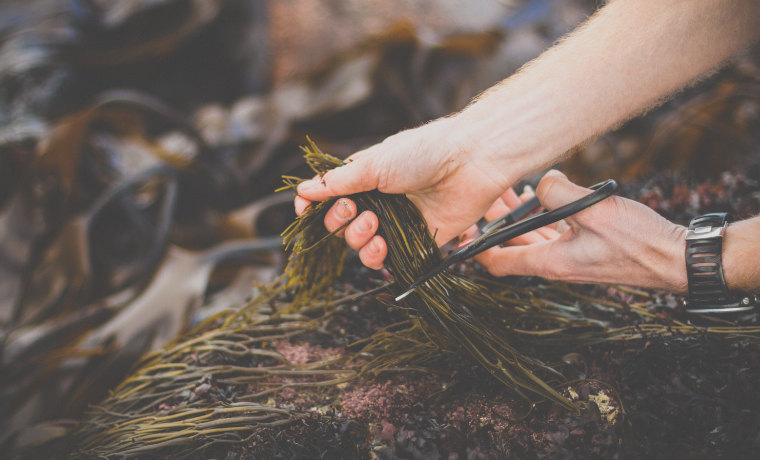
Image by Cornish Seaweed
Foraging for seaweed
If you’re already a fan of seaweed and want to try your hand at collecting it yourself, you are in luck. Even more so if you live in North America and the UK because all of the seaweed in our oceans is edible (not all in freshwater, though). The only downside to foraging for seaweed in these areas is that it won’t all taste the same, and not all of it even tastes all that good!
You’re likely to find three common types of seaweed on the east and west coasts of the US: kombu, Irish moss, and wakame, and in the UK: kelp, sea lettuce, laver. There are several others, and we recommend looking into local foraging resources to see which options are best where you live and the best places to find them.
Since seaweed is so good at absorbing nutrients in the water (both good and bad ones), it is essential that you know whether or not the areas you plan to harvest are clean. Whatever contaminants are or were in that water will likely be in the seaweed now, so take time to research and understand those risks.

Next, you need to know if collecting seaweed in your area is even legal. Seaweed is regulated in many areas, and each has its rules and regulations. Some places have a weight limit for the amount of seaweed one person can harvest, while others may have complete bans. Where you are gathering may also have regulations, and you want to ensure you’re in an area for public use, not a private shoreline.
Most areas that allow seaweed foraging have specific harvest guidelines. Follow your area’s guidelines for harvesting, so you know how to properly remove each species safely and ethically.
Finally, you can head to the water once you have waded through all the rules and regulations to get to seaweed foraging. Seaweed loves growing in rocky areas, so be careful when heading into the waters to collect. You want to gather seaweed that is still attached to rocks and can withstand the movement of waves. If you find seaweed floating or on shore, that isn’t suitable for eating. You can use it as fertiliser in your garden, though.
Once you have your seaweed, it can be enjoyed fresh or dried in many different ways.
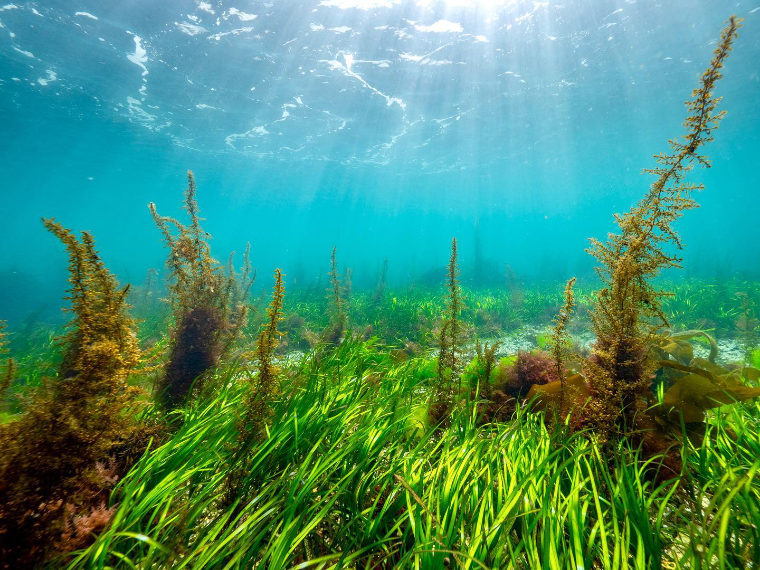
Image by Martin Stevens
Final thoughts on the benefits of seaweed
It turns out that seaweed is not only a healthy snack or a tasty part of your favourite dish, but it may be an essential tool in our fight against climate change. The benefits of seaweed are vast, and we barely scratched the surface in discussing a few health and environmental benefits.


